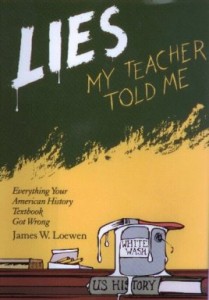Continuing on with this week’s theme… Native Americans.
What your history teacher told you : Native Americans were savages who were not civilized. New Europeans arriving in the country taught Native Americans how to act civilized.
After some exploring, the Pilgrims chose the land around Plymouth Harbor for their settlement. After harvesting their first crop, they and the Indian inhabitants became friends. Pilgrims wanted to show the natives the words and life of Jesus, so that they are saved from their own savage behavior.
The Truth:
1. “There has been some improvement in textbooks’ treatment of Native peoples in recent years. In 1961 the best-selling Rise of the American Nation contained ten illustrations featuring Native people, alone or with whites (of 268 illustrations); most of these pictures focused on the themes of primitive life and savage warfare. Twenty-five years later, the retitled Triumph of the American Nation contained fifteen illustrations of Indians; more important, no longer were Native Americans depicted as one-dimensional primitives. Rather, they were people who participated in struggles to preserve their identities and their land….”
2. “Today’s textbooks do confer civilization on some Natives. Like the Spanish conquistadors themselves, The American Adventure equates wealth and civilization: “Unlike the noncivilized peoples of the Caribbean, the Aztec were rich and prosperous.” Textbooks invariably put the civilization far away, in Mexico, Guatemala, or Peru. By comparison, “Indian life in North America was less advanced,” says The American Pageant. It seems that, despite good intentions, textbooks cannot resist contrasting “primitive” Americans with modern Europeans. Part of the problem is that the books are really comparing rural America to urban Europe-Massachusetts to London.
3. “For a long time Native Americans have been rebuking textbook authors for reserving the adjective civilized for European cultures. In 1927 an organization of Native leaders called the Grand Council Fire of American Indians criticized textbooks as “unjust to the life of our people.” They went on to ask, “What is civilization? Its marks are a noble religion and philosophy, original arts, stirring music, rich story and legend. We had these. Then we are not savages, but a civilized race.”
4. “I had expected to find in our textbooks the cliché that Native Americans did not make good slaves, but only two books; Triumph of the American Nation and The American Tradition, say even that. The American Pageant contains a paragraph that at least states the basics-“Indian slaves were among the colony’s earliest exports”-even if it gives no hint of the trade’s extent. American History buries a sentence, “A few Indians were enslaved,” in its discussion of the African slave trade. Otherwise, the twelve textbooks are silent on the subject of the Native American slave trade.”
5. “Just as American societies change when they encountered whites, so European societies change when they encountered Natives. Textbooks completely miss this side of the mutual accommodation and acculturation process. Instead, their view of white-Indian relations is dominated by the archetype of the frontier line. Textbooks present the process as a moving line of white (and black) settlement-Indians on one side, whites (and blacks) on the other.”
6. “For a hundred years after our Revolution, Americans credited Native Americans as a source of their democratic institutions. Revolutionary-ear cartoonists used images of Indians to represent the colonies against Britain…. When colonists took action to oppose unjust authority, as in the Boston Tea Part or the anti-rent protests against Dutch plantations in the Hudson River valley during the 1840’s, they chose to dress as Indians, not to blame Indians for the demonstrations but to appropriate a symbol identified with liberty.”
7. “Even in describing the French and Indian War, textbooks leave out the Indians! One of the worst defeats Indians ever inflicted on white forces was the rout of General Braddock in 1755 in Pennsylvania.”
8. “Like its predecessors, the War of 1812 cannot be understood so long as its Indian origin is obscured. Whites along the frontier wanted the war, and along the frontier most of the war was fought, beginning in November 1811 with William Henry Harrison’s attack on the Shawnees and allied tribes in Indiana, called the Battle of Tippecanoe. The United States fought five of the seven major land battles of the War of 1812 primarily against Native Americans. Nonetheless, unlike Canadian histories, none of our textbooks recognizes the involvement of Native Americans.”
9. “No matter how thoroughly Native Americans acculturated, they could not succeed in white society. Whites would not let them. “Indians were always regarded as aliens, and were rarely allowed to live within white society except on its periphery.””
10. Casting Indian history as a tragedy because Native Americans could not or would not acculturate is feel-good history for whites. By downplaying Indian wars, textbooks help us forget that we wrested the continent from Native Americans.”
11. “Anti-Indian racism has eased considerably in the twentieth century. Ironically, the very fact that the United States is beginning to let Natives acculturate successfully, albeit on Anglo terms, poses a new threat to Native coexistence. Poverty and discrimination helped isolate Indians. If Native Americans can now get good jobs, as some can, buy new vehicles and satellite televisions, as some have, and commute to the city for part of their life, as some do, it is much harder to maintain the intangible values that make up the core of Indian cultures.”

